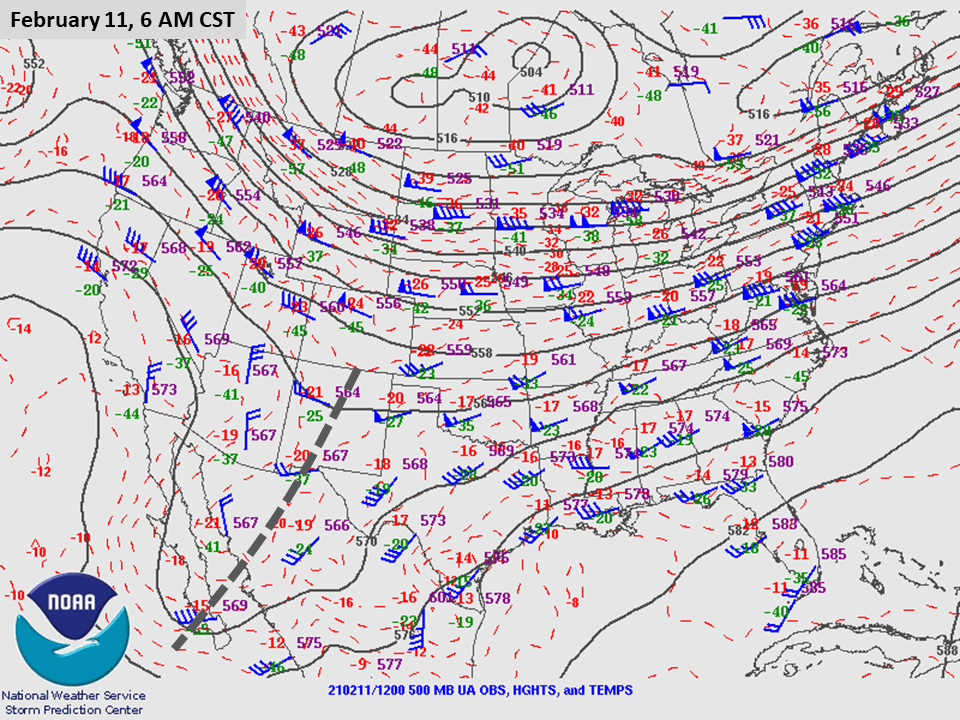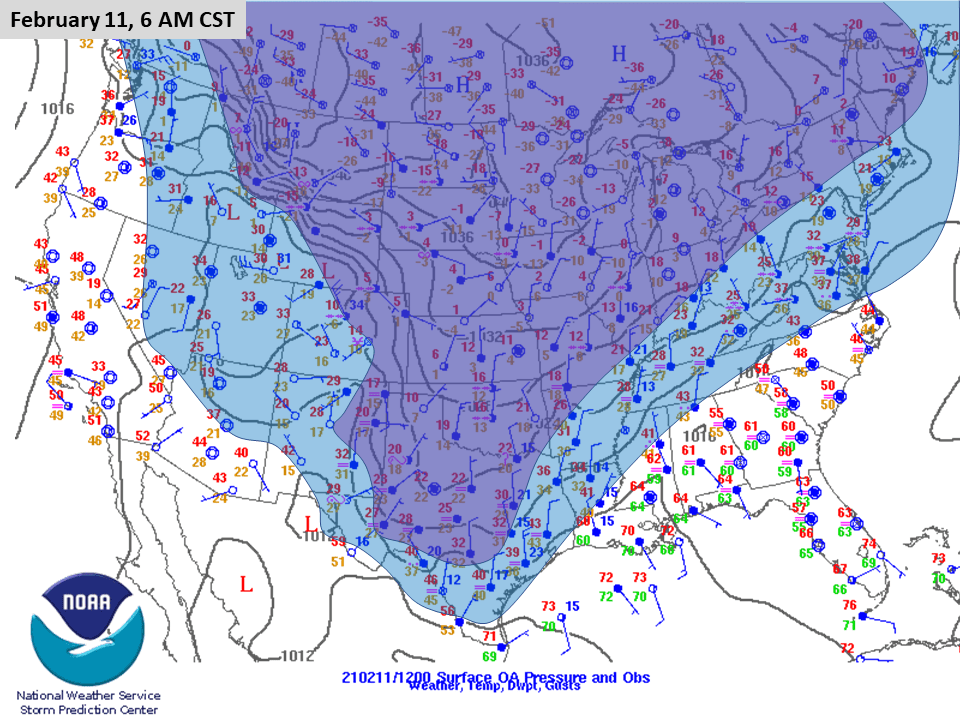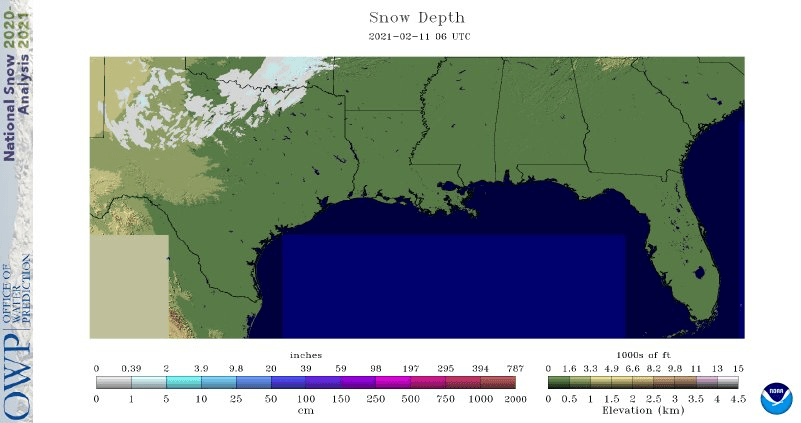In a winter that featured six minor freezes across the Lower Rio Grande Valley/Deep South Texas ranchlands in December (1st, 17th, and 25th) and January (1st, 13th, and 16th), winter 2020/2021 saved its “worst” for last, with the most intense arctic outbreak to strike the region, in terms of cold temperatures and duration, since December 22-25, 1989. Parts of the region had at least a minor freeze on the 13th through 17th, and again on the 19th and 20th.
The killing freeze occurred from late evening on Valentine’s Day through around noon on February 16th. Across parts of the ranch country, including northern Zapata through northern Kenedy County, temperatures remained at or below freezing for nearly two full days. However, unlike the most recent prolonged freeze (February 2-5, 2011), ambient temperatures fell into the mid teens to lower 20s during the morning of February 15th, and similar minimum temperatures during the morning of February 16th, with all Lower Valley and ranch locations in hard freeze (27°F or lower) for 6 to 16 hours each day, and 12 to 24 hours in total. The combination of wind and ambient temperatures made it "feel like" 0 to 10°F above during the post-daybreak hours of 7 to 9 AM on the 15th - rivaling observed values during the December 22-24, 1989 period. Another Valley-wide light freeze occurred on the 19th, with a heavy frost (along with temperatures in the upper 20s for most) ending the event early on the 20th.
The lateness of the arctic outbreak was unprecedented in the modern record, with only mid February 1895 rivaling 2021 - a time when the Rio Grande Valley’s population was less than one-tenth of what it was today. On the 15th and 16th, new record low temperatures were set everywhere. In locations with periods of record dating back to after 1895, old records were shattered by 8 to 15 degrees, including at some locations with more than 100 years of data! New records were also achieved on the 17th, 19th, and 20th, with smaller departures. Record "low maximum" temperatures were crushed at even greater differences on the 15th, with populated Valley locations breaking the old records by 14 to 20 degrees! Assorted record "low maximum" temperatures were also set prior to the big freeze on the 13th and 14th, when temperatures held in the 30s in most areas.
Summary of Impacts
Life in Texas ground to a crawl, or even a halt, as the electric grid became overwhelmed by the unprecedented late season cold and wintry precipitation. For the Lower Rio Grande Valley, this included an unknown number of water main/water pipe bursts, generator failures that affected water pressure, and other infrastructure damage to be determined. Leading into the killing freeze on the 15th was a period of light freezing rain and sleet, which coated trees and grass but also icing up elevated surfaces, causing more than 50 roads to be temporarily closed. When the value of damage to commercial agriculture and aquaculture, ornamental and nursery plants, and built infrastructure such as pipes, generators, and flooded buildings, the total direct damage count will be well over $1 billion, making it two such events (Hanna, July 2020) in less than a year. When economic loss and crop production loss are factored in, the total could exceed $2 billion for the Rio Grande Valley alone. Final values of each won't be available until later in 2021, and this article will be updated to account as new estimates arrive.
The most costly impacts were to the natural environment. The following items tell the tale (as of mid March, 2021):
PRELIMINARY LOCAL STORM REPORT...SUMMARY
NATIONAL WEATHER SERVICE BROWNSVILLE TX
..TIME... ...EVENT... ...CITY LOCATION... ...LAT.LON...
..DATE... ....MAG.... ..COUNTY LOCATION..ST.. ...SOURCE....
..REMARKS..
0830 PM FREEZING RAIN 1 S WESLACO 26.14N 97.98W
02/14/2021 E0.01 INCH HIDALGO TX AMATEUR RADIO
REPORT OF ICE ACCUMULATING AT RANCHERO
VILLAGE MOBILE HOME PARK.
0830 PM FREEZING RAIN 3 N MCALLEN 26.26N 98.24W
02/14/2021 E0.01 INCH HIDALGO TX AMATEUR RADIO
REPORT OF ICE ACCUMULATING.
0924 PM FREEZING RAIN 1 S WESLACO 26.14N 97.98W
02/14/2021 E0.06 INCH HIDALGO TX AMATEUR RADIO
ICE ACCUMULATION OF 1/16TH OF AN INCH.
0941 PM FREEZING RAIN 2 SW COMBES 26.23N 97.75W
02/14/2021 E0.01 INCH CAMERON TX PUBLIC
REPORTS OF SLEET AND ICE ACCUMULATING ON
TRASH CAN.
1125 PM FREEZING RAIN FALFURRIAS 27.23N 98.14W
02/14/2021 E0.10 INCH BROOKS TX DEPT OF HIGHWAYS
BOTH NORTHBOUND AND SOUTHBOUND SECTIONS OF HIGHWAY 281
CLOSED IN FALFURRIAS DUE TO ICING ON OVERPASS. TRAFFIC
BEING DETOURED TO FRONTAGE ROAD. SOURCE
WWW.DRIVETEXAS.ORG.
1125 PM FREEZING RAIN ENCINO 26.93N 98.13W
02/14/2021 E0.10 INCH BROOKS TX DEPT OF HIGHWAYS
BOTH NORTHBOUND AND SOUTHBOUND SECTIONS OF HIGHWAY 281
CLOSED IN ENCIO DUE TO ICING/SNOW ON OVERPASS. TRAFFIC
BEING DETOURED TO FRONTAGE ROAD. SOURCE
WWW.DRIVETEXAS.ORG.
1201 AM FREEZING RAIN SARITA 27.22N 97.80W
02/15/2021 E0.10 INCH KENEDY TX LAW ENFORCEMENT
BOTH NORTHBOUND AND SOUTHBOUND SECTIONS OF THE
INTERSTATE 69E OVERPASS IN SARITA ARE CLOSED DUE TO
ICING. TRAFFIC IS BEING DETOURED TO FRONTAGE ROAD.
REPORT SOURCE WWW.DRIVETEXAS.ORG AND THE SARITA SHERIFFS
OFFICE.
1229 AM SLEET PHARR 26.18N 98.19W
02/15/2021 E0.2 INCH HIDALGO TX AMATEUR RADIO
HAM RADIO OPERATOR IN PHARR REPORTED TOTAL FREEZING
RAIN, SLEET AND SNOW ACCUMULATION OF 1/4 TO 1/2 OF AN
INCH.
1230 AM FREEZING RAIN LOPEZVILLE 26.24N 98.16W
02/15/2021 U0.00 INCH HIDALGO TX DEPT OF HIGHWAYS
OWASSA FLYOVER ON INTERSTATE I69C NEAR LOPEZVILLE IS
CLOSED DUE TO ICING. REPORT SOURCE WWW.DRIVETEXAS.ORG
1240 AM FREEZING RAIN THOMPSONVILLE 27.21N 98.94W
02/15/2021 U0.00 INCH JIM HOGG TX DEPT OF HIGHWAYS
ICE AND SNOW ACCUMULATING ON BRIDGES AND OVERPASSES
(BOTH EAST AND WESTBOUND LANES) ON FM649 IN
THOMPSONVILLE. TRAVEL IS BEING DISCOURAGED. SOURCE
WWW.DRIVETEXAS.ORG
1243 AM FREEZING RAIN ZAPATA 26.89N 99.26W
02/15/2021 U0.00 INCH ZAPATA TX DEPT OF HIGHWAYS
MULTIPLE REPORTS RECEIVED VIA DRIVETEXAS.ORG OF ICING
OCCURRING ON BRIDGES AND OVERPASSES ON HIGHWAY 83 IN
ZAPATA COUNTY. TRAVEL IN ZAPATA COUNTY IS BEING
DISCOURAGED.
1245 AM FREEZING RAIN RIO GRANDE CITY 26.38N 98.83W
02/15/2021 U0.00 INCH STARR TX DEPT OF HIGHWAYS
MULTIPLE REPORTS RECEIVED VIA DRIVETEXAS.ORG OF ICE AND
SNOW ACCUMLATION OCCURRING ON BRIDGES AND OVERPASSES ON
HIGHWAY 83, FM1017, FM2686, FM2294, FM2844, FM755,
FM649, FM3167 AND FM2360 IN STARR COUNTY. TRAVEL IN
STARR COUNTY IS BEING DISCOURAGED.
0100 AM FREEZING RAIN RAYMONDVILLE 26.48N 97.78W
02/15/2021 U0.00 INCH WILLACY TX LAW ENFORCEMENT
MULTIPLE REPORTS OF ICING ON FM490 AND FM186 BRIDGES
AND OVERPASSESS IN WILLACY COUNTY.
0200 AM FREEZING RAIN BROWNSVILLE 25.93N 97.48W
02/15/2021 M0.02 INCH CAMERON TX NWS EMPLOYEE
NWS BROWNSVILLE EMPLOYEES MEASURED 0.02 INCHES OF
FREEZING RAIN ACCRETING ON VEHICLES IN OFFICE PARKING
LOT. ICE IS ALSO ACCRETING ON GRASS IN THE OFFICE YARD
AND TREES, BUT NOT ON THE PARKING LOT ASPHALT.
0207 AM FREEZING RAIN HARLINGEN 26.20N 97.69W
02/15/2021 U0.00 INCH CAMERON TX LAW ENFORCEMENT
HARLINGEN PD IS REPORTING THAT THE ARROYO BRIDGE AT
1500 SOUTH 77 SUNSHINE STRIP IS COMPLETELY ICED OVER.




















Meteorology
Similar to all of Texas, the event was created by a pool of arctic air that was brought into the northern Great Plains by a "piece" of the circumpolar vortex that slid south toward the Canadian/US border soon after February began. Surface high pressure, reinforced by the presence of the piece of the vortex, oozed into the northern and central Plains, then continued steadily southward, bringing subfreezing temperatures and winter precipitation into north and central Texas around the 10th. Much below average temperatures, but still above freezing (mainly 30s and 40s), crashed into the Lower Valley late on the 11th, and locked in through Valentine’s Day under a steel gray low overcast with occasional drizzle and biting north wind. A strong upper level disturbance, extending from southwest Canada through northwest Mexico, slid eastward late on the 14th and 15th, bringing the seasonally unprecedented surge of frigid air deep into Mexico.
Additional upper level impulses crossed Texas through the 19th, with the final wave exiting the state that day. Each impulse kept the much colder than average air locked in (loop below, on the left). A warm up finally arrived on the 20th, and would continue through the end of the month.
The Event in Context of Winter 2020/21
Preseason outlooks issued as early as October and November, 2020, hinted at the potential for multiple freezes in a winter (December through February) that was forecast to end up warmer and drier than average. Through January, this was indeed the case, as mentioned in the Overview section on the first tab of this report. Though more study will help discover reasons for the unprecented (in time and year) event, a few puzzle pieces stand out. First, the idea of embedded cold outbreaks amidst the warmth was predicated on the continuation of a moderate La Niña. When combined with a persistent negative phase of the Pacific-Decadal Oscillation, which can enhance the impacts of a La Niña the possibility of intrusions of Canadian air makes sense. In 2021, a third atmospheric teleconnection joined these two - a brief but strongly negative phase of the Arctic Oscillation. A similar, strongly negative phase in January 2011 may have previewed the early February freeze and cold snaps through the Great Plains. That year, the phase changed on a dime in February, and warm to hot weather arrived in late February. In 2021, the phase shifted a couple weeks later, not in time to turn the monthly average from negative to positive. March 2021 started generally positive and slightly warmer than average weather prevailed.
For the steering flow pattern animation (left), dashed gray lines represented upper level disturbances that brought wintry precipitation, surges of frigid air, or both. The main wave late on February 14th provided both. Later reinforcing energy waves from the 16th through 18th reinforced cold temperatures across the Valley, but brought more wintry precipitation from south central Texas to north and east Texas through the period, before clearing arrived late on the 19th and warming followed after a final frozen morning on the 20th. For the surface temperatures (right), blue colors represent 15 to 25 degree departures from average, and purple colors more than 25 degree departures from mid February averages - in general, based on temperatures at 6 AM and 6 PM (central time) each day.
| US 500 mb pattern, February 11 through 20, 2021 | US surface weather conditions, February 11 through 20, 2021 |
|---|---|
 |
 |
Two key elements on the ground were likely triggers for the intensity and duration of the killing freeze event (late February 14 through noon on February 16th). First, temperatures on Valetine’s Day rose little across the region - in fact, values began falling back toward freezing well before sunset across the Brush Country. This gave the entire region a "head start" on the temperature drop. In addition, snow and sleet accumulation just north of Deep South Texas was underway on the 14th, which allowed for minimal modification of the true arctic airmass that was headed south. This was evident by the small range of temperatures across most of the region, from the mid to upper teens across the ranches to 20-22 everywhere else, including on South Padre Island. That same snow pack held on through the week, ensuring that cold air would remain entrenched across the Valley. Fortunately, some late February sunshine on the 17th and 19th allowed readings to pop into the 50s (except along the coast)...relatively mild but still more than 20 degrees below daytime averages.
| Loop of Southern Plains Snowpack |
|---|
 |